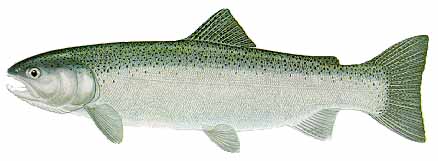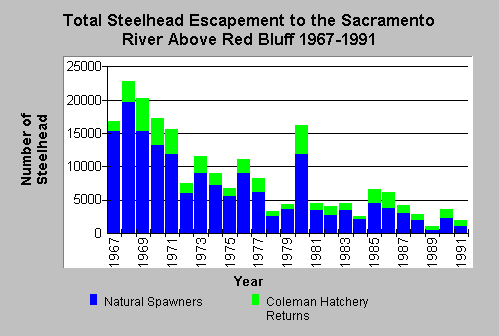

 |
 |
|
 |
| Oncorhynchus mykiss
Adult Steelhead
Illustration by Ron
Pittard from
the Comprehensive Guide to Western Gamefish by Ed Lusch
|
Steelhead trout are sea-going rainbow trout. They are very agile, and can jump water falls up to 15 feet high. Although they do not get as large as chinook and coho salmon, they have the advantage of sometimes remaining alive after spawning. Unlike salmon, all of which do die after spawning, steelhead may spawn more than once.
Steelhead often live in swift streams flowing out of the mountains. Very small fish live in shallow riffles and calm pools at the stream's edge. Older juvenile steelhead claim and defend positions in larger riffles, where food is delivered by the flowing water. They retreat to deep, cold pools to rest. The young fish stay in freshwater from one to three years before migrating to sea.
Steelhead spawn in practically every tributary of the upper Sacramento River, and appear to do so in numbers proportionate to a given tributary's runoff. That is, large streams such as Mill, Deer, and Battle creeks have the largest runs (Hallock 1961, 1989). Actual numbers of naturally spawning steelhead in these streams are generally unknown. However, an average of 1160 steelhead per year migrated into Mill Creek during a 10 year period from 1954 to 1963 (CDFG n.d.).
 |
From 1967 to 1991, estimated numbers of naturally spawning steelhead passing Red Bluff Diversion Dam (RBDD) ranged from a high of 19,615 in 1968 to a low of 470 in 1989. (Table 5; CDFG 1994c). Based on data from 1967 to 1974, 28 percent of the adult steelhead migrating past RBDD spawned in the upper reaches of the Sacramento River tributaries including Battle, Cottonwood, and Cow Creeks, 28 percent spawned at the CNFH, and the remaining 46 percent were caught by sport anglers; very few steelhead spawn in the mainstem Sacramento River (USFWS 1984). Steelhead trout inhabit the Battle Creek watershed throughout the year at various life stages. The typical spawning period for steelhead populations in the upper Sacramento River, including, presumably, the Battle Creek population, begins in December and lasts through April (Schafter 1980; CDFG 1990). Steelhead eggs hatch by late-May and the juveniles likely spend a year or more in Battle Creek before migrating to the Pacific Ocean. CDFG (1990) provides many more details about the life history and habitat requirements of steelhead trout. |
![]()
References
McEwan, D. and T. A. Jackson, 1996. Steelhead restoration and management plan for California. California Department of Fish and Game, Inland Fisheries Division. Sacramento, CA . 244 pp. [3.2Mb] **
Moyle, P. B., R.M. Yoshiyama, and R.A. Knapp, 1996. Status of fish and fisheries. Chapter 33 of Sierra Nevada Ecosystem Project: Final report to Congress. Vol. II, Assessments and scientific basis for management options. University of California, Centers for Water and Wildland Resources. Davis, CA. 21 pp. [450kb]
Ward, M. B. and W.M. Kier, 1999. Battle Creek salmon and steelhead restoration plan. Prepared for the Battle Creek Working Group by Kier Associates. Sausalito, CA . 157 pp. [1.4 Mb]